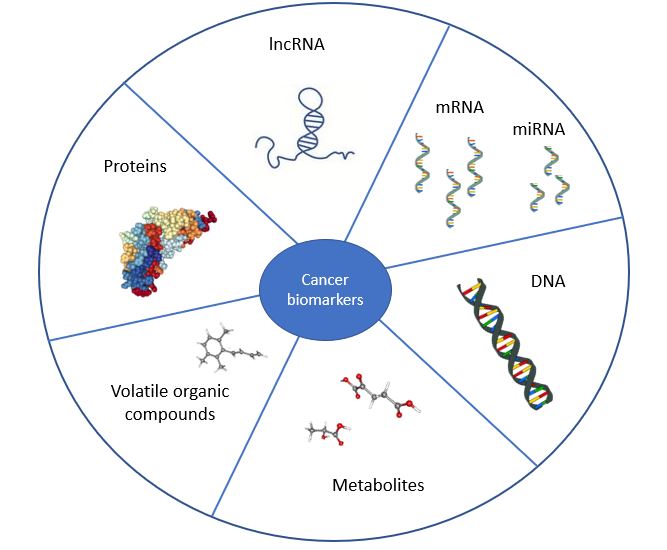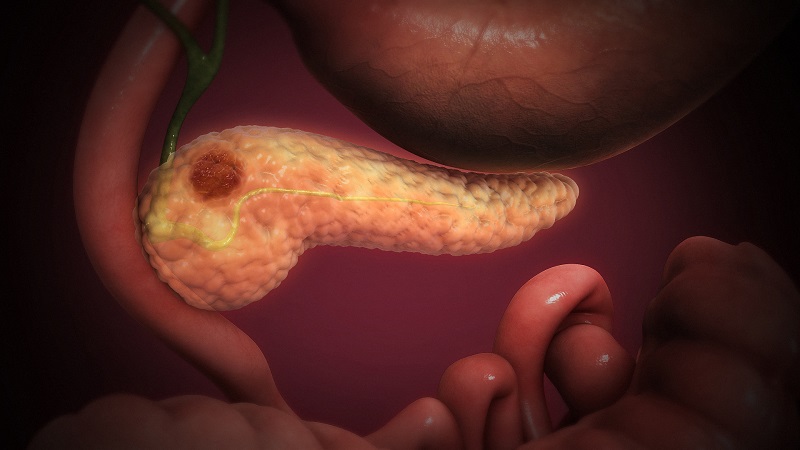Frequently, I am asked, “Isn’t there a blood test for pancreatic cancer?” I think this question arises because, as my friends and I are getting older, we have more friends, relatives, and acquaintances who are diagnosed with cancer, and those with pancreatic cancer are the ones that tend to die soonest. Many have heard of a blood test, but few understand why it seems that most patients with this deadly cancer fail to be detected in the early stages. Pancreatic cancer is particularly challenging to diagnose, because there are few consistent symptoms in the early stages of the disease. Additionally, the symptoms are similar to other noncancerous conditions and many of the symptoms arise from the cancer reaching an advanced stage or spreading. Finally, pancreatic cancer is fairly rare, representing only ~3% of cancers in the U.S. Thus, this type of cancer is seldom the first or second thought for most clinicians who see patients that present with symptoms that might be pancreatic cancer.
The symptoms of pancreatic cancer include pain in the abdomen or back, jaundice due to liver metastases or compression of the bile duct, loss of appetite, nausea and vomiting, and weight loss. An enlarged liver or gall bladder are also common. Each of these symptoms nearly always arises after the cancer has reached an advanced stage. Occasionally, patients may have deep vein thrombosis, which is a type of blood clot, or high blood sugar. Because pain and issues related to appetite or trouble eating rarely are due to pancreatic cancer, typically all other sources of the problem are ruled out before any tests that would reveal this type of cancer are ordered. Pancreatic cancer is often detected by imaging, for example when an MRI is ordered to determine if there is pulled muscle or other explanation for the pain. Subsequent biopsy and blood tests confirm the suspected diagnosis. Although surgery is possible in some cases, the surgical procedures carry very high risks and complications. Most often, though, the cancers are too advanced for the patient to benefit from surgery.
There are two proteins that are sometimes increased in the blood of patients with pancreatic cancer: CA19-9 (carbohydrate antigen 19-9) and CEA (carcinoembryonic antigen). There are 2 reasons that these two proteins are not used as an early detection screen. The amounts of these proteins in the blood are not high in all patients with pancreatic cancer and some people without pancreatic cancer may have high levels. So these tests yield both false negatives (not detecting all patients with the disease) and false positives (indicating the disease in patients that do not have it). However, in pancreatic cancer patients that do have high amounts of these proteins, the amounts of these two proteins can be used to monitor treatment.

Figure 1. Sources of potential biomarkers for cancer. [More details]
Researchers are trying to identify alternative markers than CA19-9 and CEA that would have a higher accuracy for diagnosing pancreatic cancer, especially in the early stages. Researchers are examining multiple types of biological molecules from various bodily fluids (Figure 1). A study for urine-based markers used mass spectometry to identify a profile of volatile organic compounds (organic gases) that could discriminate between pancreatitis, pancreatic cancer, and healthy subjects. Others are trying to find tumor cells that have been shed from the cancer into the blood and identify those by single-cell genomic analysis or by defining cancer-specific changes in gene expression, referred to as transcriptional profiles, in these circulating tumor cells. Other studies are examining vesicles shed by tumor cells or cells that support the tumor cells. These vesicles are called exosome, can be isolated from the circulation, and contain proteins and RNA molecules but do not contain DNA. Changes in the abundance of type of RNA called long noncoding RNAs or microRNAs, which can be found in exosomes or in circulating tumor cells, are also potential biomarkers of disease. Long noncoding RNAs and microRNAs are regulatory RNA molecules that, instead of producing proteins like mRNAs do, influence the expression of genes or the function of proteins. Cellular metabolism is altered in cancer. There may be a particular metabolic profile associated with different stages of pancreatic cancer. This profile could be detected using metabolomic analysis of blood, urine, saliva, or other body fluids. It may be that early detection of pancreatic cancer will require a combination of metabolite markers, genomic tumor markers, circulating protein markers, and various types of RNA markers.
These biomarker strategies are not limited to pancreatic cancer, of course. Researchers are trying to find easy, fast, safe, noninvasive approaches to early detection of all cancers and to monitor disease progression or response to treatment.
Update 7 August 2019: The 2019 recommendation from the US Preventative Services Task Force (USPSTF) reaffirms the recommendation against screening for pancreatic cancer in adults without any symptoms. https://jamanetwork.com/journals/jama/fullarticle/2740727 | PubMed
Update 7 August 2019: This article is also available through Medium.
Related Resources
Pancreatic cancer. American Cancer Society (accessed 5 April 2019) https://www.cancer.org/cancer/pancreatic-cancer.html
L. Follia et al., Integrative analysis of novel metabolic subtypes in pancreatic cancer fosters new prognostic biomarkers. Front. Oncol. 9, 115 (2019). DOI:
10.3389/fonc.2019.00115. PubMed
R. Nelson, US task force gives thumbs down to pancreatic cancer screening. Medscape (5 February 2019) https://www.medscape.com/viewarticle/908676
S. I. Nissen, et al., Detection of pancreatic cancer by urine volatile organic compound analysis. Anticancer Res. 39, 73-79 (2019). DOI:
10.21873/anticanres.13081 PubMed
X. Yu, et al. Analysis of distinct long noncoding RNA transcriptional fingerprints in pancreatic ductal adenocarcinoma. Cancer Med. 6, 673-680 (2017). DOI:
10.1002/cam4.102 PubMed
Z. Li et al. Tumor-derived exosomal lnc-Sox2ot promotes EMT and stemness by acting as a ceRNA in pancreatic ductal adenocarcinoma. Oncogene 37, 3822-3838 (2018). DOI: 10.1038/s41388-018-0237-9 PubMed
Cite as: N. R. Gough, Pancreatic cancer: A biomarker challenge. BioSerendipity (8 April 2019).
https://www.bioserendipity.com/pancreatic-cancer-a-biomarker-challenge/

